

|
|
Δείτε εδώ τα πιο πρόσφατα μηνύματα από όλες τις περιοχές συζητήσεων, καθώς και όλες τις υπηρεσίες της AcroBase. H εγγραφή σας είναι γρήγορη και εύκολη. |
|
|||||||
|
 |
|
|
Εργαλεία Θεμάτων | Τρόποι εμφάνισης |
 |
#3151
|
 |
|
||||
|
Discover the cosmos! Each day a different image or photograph of our fascinating universe is featured, along with a brief explanation written by a professional astronomer. 2015 June 6  Image Credit: NASA, Gemini Project, James McDivitt Tomorrow's picture: expressive dim star Πηγή
__________________
όταν γράφεται η ιστορία της ζωής σου, μην αφήνεις κανέναν να κρατάει την πένα |
 |
#3152
|
 |
|
||||
|
Discover the cosmos! Each day a different image or photograph of our fascinating universe is featured, along with a brief explanation written by a professional astronomer. 2015 June 7 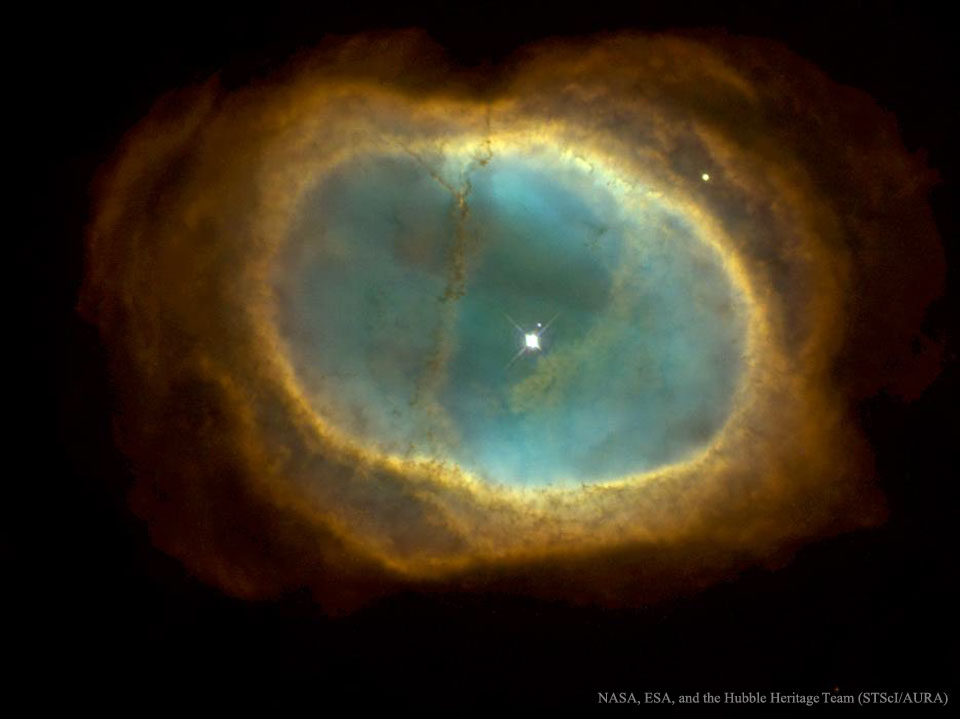 Image Credit: NASA, ESA, and the Hubble Heritage Team (STScI/AURA) Explanation: It's the dim star, not the bright one, near the center of NGC 3132 that created this odd but beautiful planetary nebula. Nicknamed the Eight-Burst Nebula and the Southern Ring Nebula, the glowing gas originated in the outer layers of a star like our Sun. In this representative color picture, the hot blue pool of light seen surrounding this binary system is energized by the hot surface of the faint star. Although photographed to explore unusual symmetries, it's the asymmetries that help make this planetary nebula so intriguing. Neither the unusual shape of the surrounding cooler shell nor the structure and placements of the cool filamentary dust lanes running across NGC 3132 are well understood. Tomorrow's picture: sea upon sky Πηγή
__________________
όταν γράφεται η ιστορία της ζωής σου, μην αφήνεις κανέναν να κρατάει την πένα |
 |
#3153
|
 |
|
||||
|
Discover the cosmos! Each day a different image or photograph of our fascinating universe is featured, along with a brief explanation written by a professional astronomer. 2015 June 8 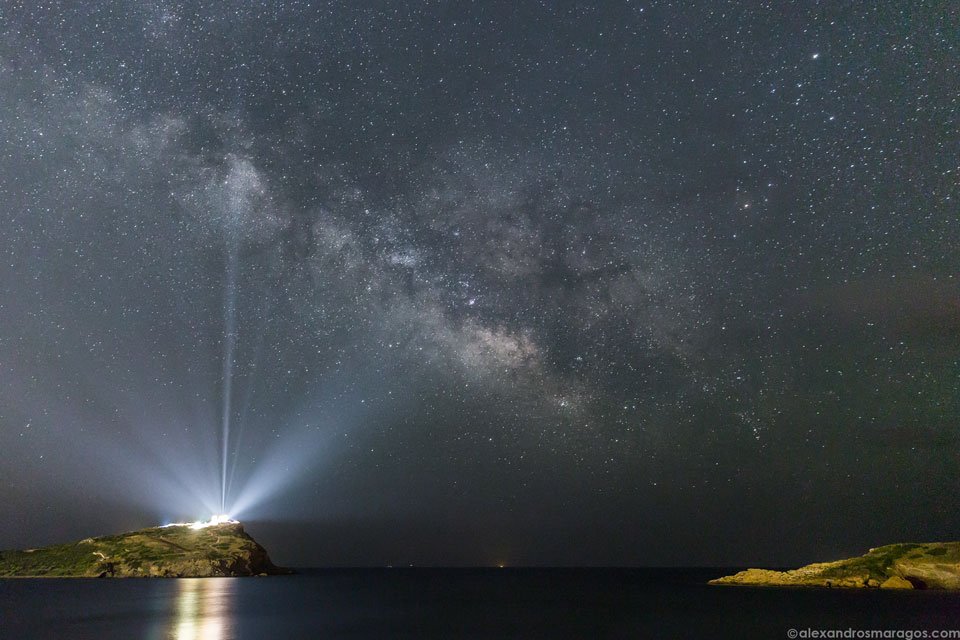 Image Credit & Copyright: Alexandros Maragos; Rollover Annotation: Judy Schmidt Explanation: What's that glowing in the distance? Although it may look like a lighthouse, the rays of light near the horizon actually emanate from the Temple of Poseidon at Cape Sounion, Greece. Some temple lights are even reflected in the Aegean Sea in the foreground. Although meant to be a monument to the sea, in this image, the temple's lights seem to be pointing out locations on the sky. For example, the wide ray toward the right fortuitously points toward the Lagoon Nebula in the central band of our Milky Way, which runs diagonally down the image from the upper left. Also, the nearly vertical beam seems to point toward the star clouds near the direction of the Wild Duck open cluster of stars. The featured image was taken less than three weeks ago. Tomorrow's picture: galaxy crash Πηγή Σχόλιο : Φοβερή φωτογραφία!!!
__________________
όταν γράφεται η ιστορία της ζωής σου, μην αφήνεις κανέναν να κρατάει την πένα |
 |
#3154
|
 |
|
||||
|
Discover the cosmos! Each day a different image or photograph of our fascinating universe is featured, along with a brief explanation written by a professional astronomer. 2015 June 9 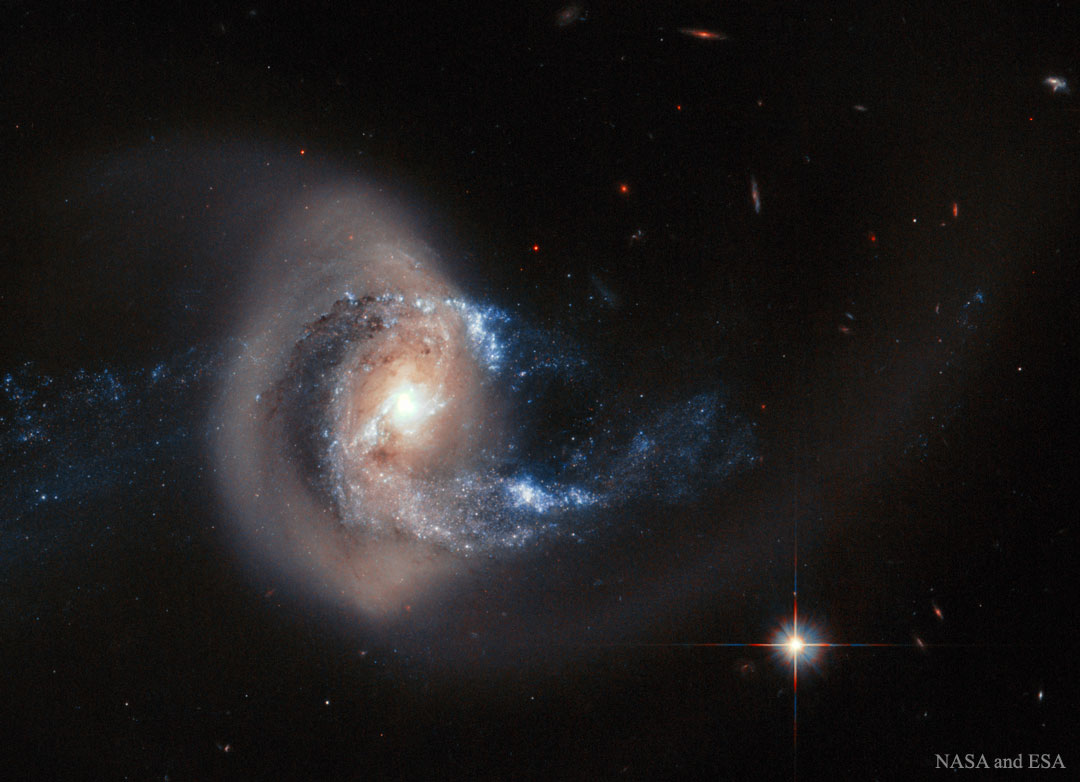 Image Credit: NASA, ESA; Acknowledgement: A. Gal-Yam (Weizmann Inst.) Explanation: Is this galaxy jumping through a giant ring of stars? Probably not. Although the precise dynamics behind the featured image is yet unclear, what is clear is that the pictured galaxy, NGC 7714, has been stretched and distorted by a recent collision with a neighboring galaxy. This smaller neighbor, NGC 7715, situated off to the left of the featured frame, is thought to have charged right through NGC 7714. Observations indicate that the golden ring pictured is composed of millions of older Sun-like stars that are likely co-moving with the interior bluer stars. In contrast, the bright center of NGC 7714 appears to be undergoing a burst of new star formation. NGC 7714 is located about 100 million light years away toward the constellation of the Fish (Pisces). The interactions between these galaxies likely started about 150 million years ago and should continue for several hundred million years more, after which a single central galaxy may result. Πηγή
__________________
όταν γράφεται η ιστορία της ζωής σου, μην αφήνεις κανέναν να κρατάει την πένα |
 |
#3155
|
 |
|
||||
|
Discover the cosmos! Each day a different image or photograph of our fascinating universe is featured, along with a brief explanation written by a professional astronomer. 2015 June 10 Video Credit: NASA, JPL-Caltech, UCLA, MPS/DLR/IDA, DLR, ESO Explanation: What would it look like to fly over dwarf planet Ceres? Animators from the German Aerospace Center recently took actual images and height data from NASA's robotic Dawn mission -- currently visiting Ceres -- to generate several fascinating virtual sequences. The featured video begins with a mock orbit around the 950-km wide space rock, with the crater featuring two of the enigmatic white spots soon rotating into view. The next sequences take the viewer around the Ceres' north and south poles, and then over a limb of the dark world highlighting its heavily cratered surface. Here, terrain height on the asteroid belt's largest object has been digitally doubled, while an artificial star field has been added in the background. The Dawn spacecraft will likely remain an unusual artificial moon of Ceres long after its mission concludes. Tomorrow's picture: open space Πηγή
__________________
όταν γράφεται η ιστορία της ζωής σου, μην αφήνεις κανέναν να κρατάει την πένα |
 |
#3156
|
 |
|
||||
|
Discover the cosmos! Each day a different image or photograph of our fascinating universe is featured, along with a brief explanation written by a professional astronomer. 2015 June 11 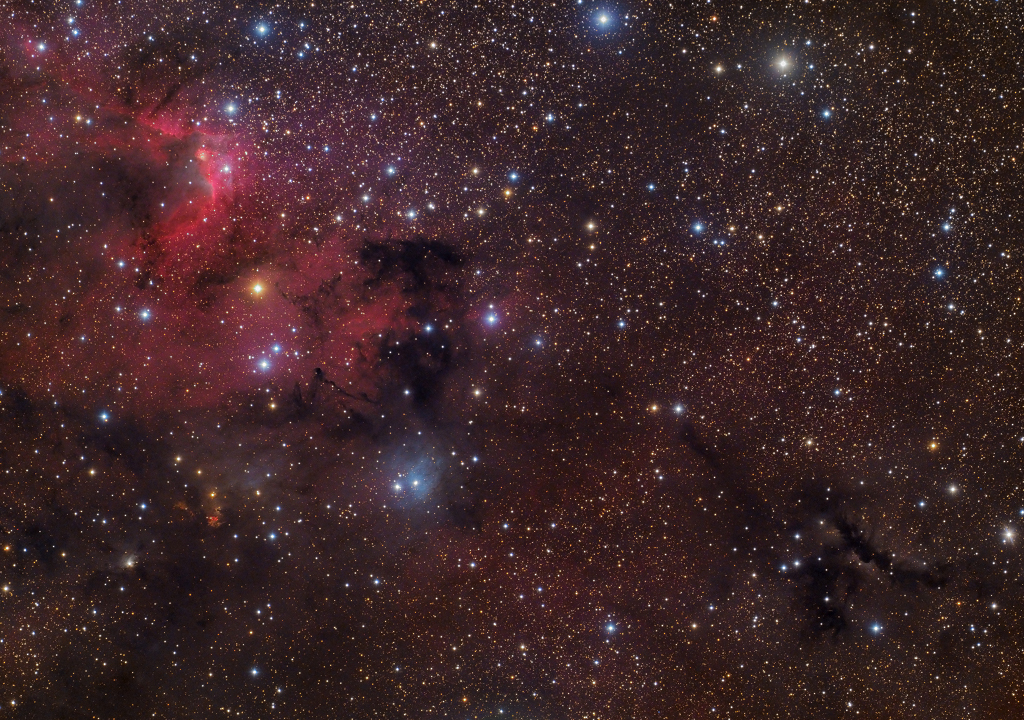 Image Credit & Copyright: Herbert Walter, CEDIC Team Explanation: This colorful skyscape spans about three full moons (1.5 degrees) across nebula rich starfields along the plane of our Milky Way Galaxy in the royal northern constellation Cepheus. Near the edge of the region's massive molecular cloud some 2,400 light-years away, bright reddish emission region Sharpless (Sh) 155 lies at the upper left, also known as the Cave Nebula. About 10 light-years across the cosmic cave's bright rims of gas are ionized by ultraviolet light from hot young stars. Dusty blue reflection nebulae also abound on the interstellar canvas cut by dense obscuring clouds of dust. The long core of the Lynds Dark Nebula (LDN) 1210 anchors the scene at lower right. Astronomical explorations have revealed other dramatic signs of star formation, including the bright red fleck of Herbig-Haro (HH) 168. Directly below the bright Cave Nebula, the Herbig-Haro object emission is generated by energetic jets from a newborn star. Tomorrow's picture: pixels in space Πηγή
__________________
όταν γράφεται η ιστορία της ζωής σου, μην αφήνεις κανέναν να κρατάει την πένα |
 |
#3157
|
 |
|
||||
|
Discover the cosmos! Each day a different image or photograph of our fascinating universe is featured, along with a brief explanation written by a professional astronomer. 2015 June 12 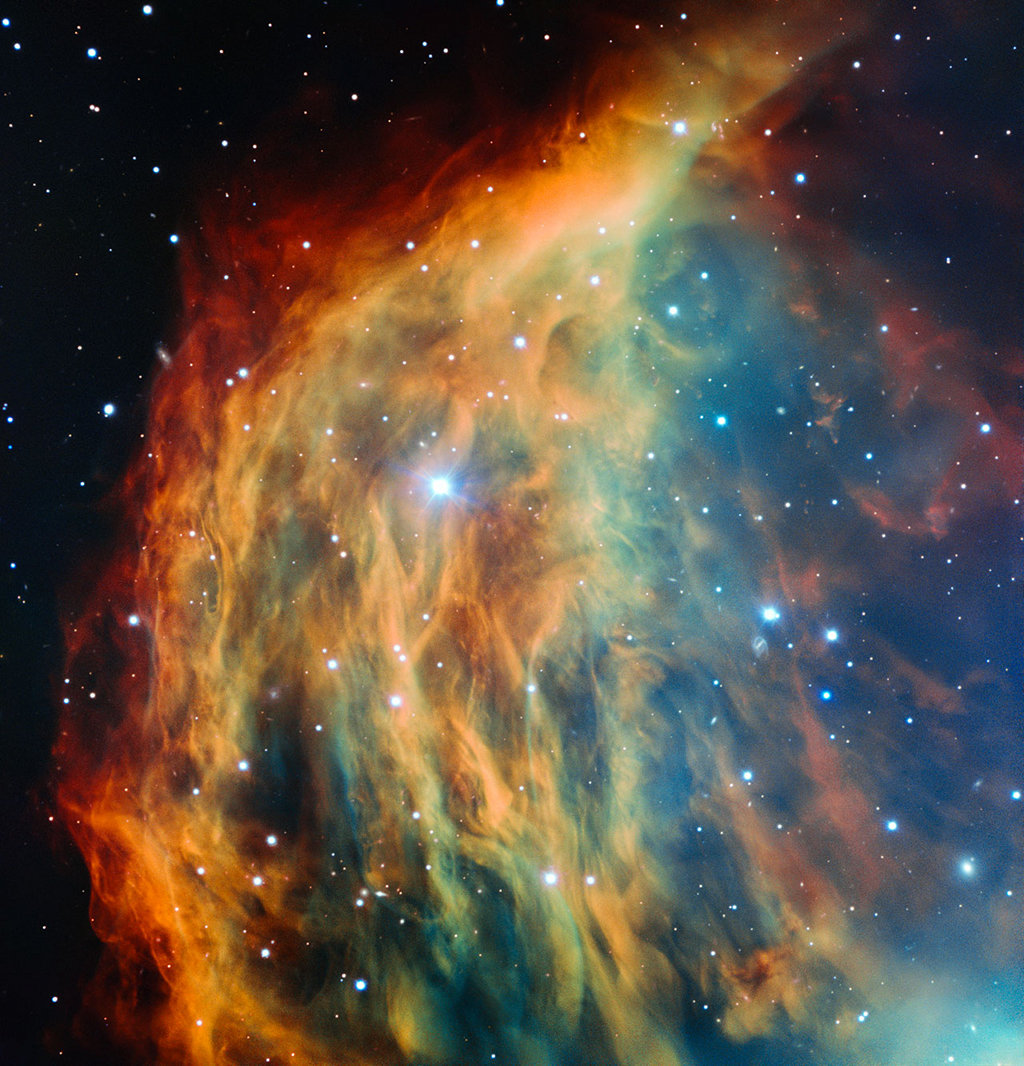 Image Credit & Copyright: European Southern Observatory, VLT Explanation: Braided, serpentine filaments of glowing gas suggest this nebula's popular name, The Medusa Nebula. Also known as Abell 21, this Medusa is an old planetary nebula some 1,500 light-years away along the southern border of the constellation Gemini. Like its mythological namesake, the nebula is associated with a dramatic transformation. The planetary nebula phase represents a final stage in the evolution of low mass stars like the sun, as they transform themselves from red giants to hot white dwarf stars and in the process shrug off their outer layers. Ultraviolet radiation from the hot star powers the nebular glow. An unrelated, bright, foreground star is near center in this close-up, telescopic view, while the Medusa's transforming central star is actually the dimmer star below center and toward the right-hand part of the frame. The Medusa Nebula is estimated to be over 4 light-years across. Tomorrow's picture: light-weekend Πηγή
__________________
όταν γράφεται η ιστορία της ζωής σου, μην αφήνεις κανέναν να κρατάει την πένα |
 |
#3158
|
 |
|
||||
|
Discover the cosmos! Each day a different image or photograph of our fascinating universe is featured, along with a brief explanation written by a professional astronomer. 2015 June 13 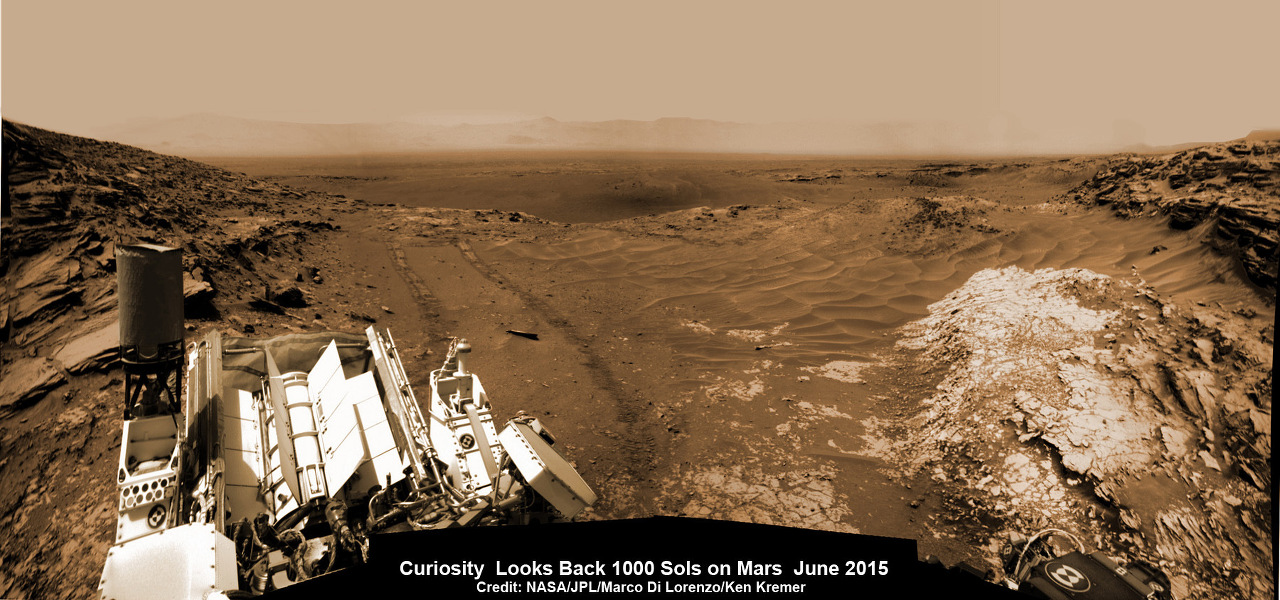 Image Credit: NASA, JPL-Caltech; Mosaic Processing: Marco Di Lorenzo, Kenneth Kremer Explanation: Shortly before Mars' June 2015 conjunction, the Curiosity Rover celebrated 1000 sols on the red planet. After its August 5, 2012 landing, Curiosity's 1000th sol or martian day on the surface corresponded to planet Earth's calendar date May 31, 2015. Because the line-of-sight to Mars is close to the Sun near the conjunction, radio communications are affected and the six-wheeled, car-sized robotic rover cautiously remains parked at this spot for now. The view looks back toward the stomping grounds for Curiosity's nearly 10.6 kilometer trek so far, with the hazy rim of Gale Crater in the distance. The mosaicked panorama was constructed with images from navigation cameras taken on Curiosity's sol 997. Tomorrow's picture: Pinwheel MCI Πηγή
__________________
όταν γράφεται η ιστορία της ζωής σου, μην αφήνεις κανέναν να κρατάει την πένα |
 |
#3159
|
 |
|
||||
|
H σελίδα του Apod είναι κατεβασμένη.
__________________
όταν γράφεται η ιστορία της ζωής σου, μην αφήνεις κανέναν να κρατάει την πένα |
 |
#3160
|
 |
|
||||
|
Discover the cosmos! Each day a different image or photograph of our fascinating universe is featured, along with a brief explanation written by a professional astronomer. 2015 June 16 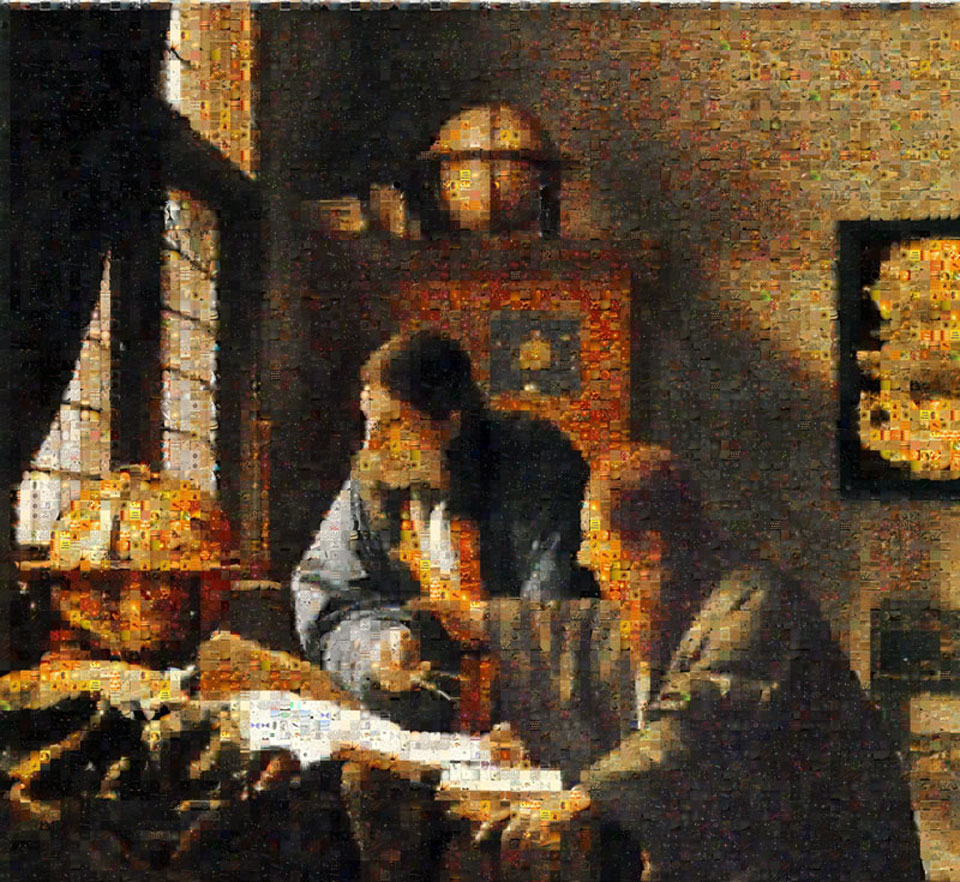 Image Credit & Copyright: Apologies to: Vermeer's Astronomer and Geographer; Image Pixelation: Rob Stevenson Explanation: Welcome to the vicennial year of the Astronomy Picture of the Day! Perhaps a source of web consistency for some, APOD is still here. As during each of the 20 years of selecting images, writing text, and editing the APOD web pages, the occasionally industrious Robert Nemiroff (left) and frequently persistent Jerry Bonnell (right) are pictured above plotting to highlight yet another unsuspecting image of our cosmos. Although the featured image may appear similar to the whimsical Vermeer composite that ran on APOD's fifth anniversary, a perceptive eye might catch that it has been digitally re-pixelated using many of the over 5,000 APOD images that have appeared over APOD's tenure. (Can you find any notable APOD images?) Once again, we at APOD would like to offer a sincere thank you to our readership for continued interest, support, and many gracious communications. If you consider yourself a fan of APOD, you might want to consider joining the Friends of APOD. 20th Anniversary Interview: An oral history of Astronomy Picture of the Day Tomorrow's picture: open space Πηγή
__________________
όταν γράφεται η ιστορία της ζωής σου, μην αφήνεις κανέναν να κρατάει την πένα |
 |
#3161
|
 |
|
||||
|
Discover the cosmos! Each day a different image or photograph of our fascinating universe is featured, along with a brief explanation written by a professional astronomer. 2015 June 17 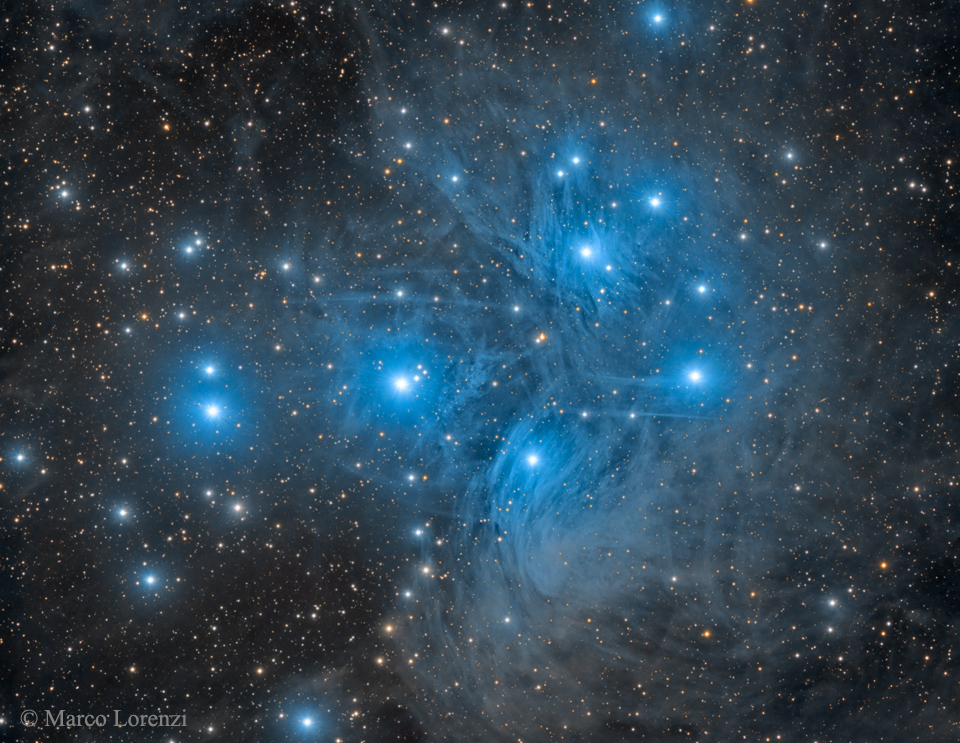 Image Credit & Copyright: Marco Lorenzi (Glittering Lights) Explanation: Have you ever seen the Pleiades star cluster? Even if you have, you probably have never seen it as dusty as this. Perhaps the most famous star cluster on the sky, the bright stars of the Pleiades can be seen without binoculars from even the depths of a light-polluted city. With a long exposure from a dark location, though, the dust cloud surrounding the Pleiades star cluster becomes very evident. The featured exposure took over 12 hours and covers a sky area several times the size of the full moon. Also known as the Seven Sisters and M45, the Pleiades lies about 400 light years away toward the constellation of the Bull (Taurus). A common legend with a modern twist is that one of the brighter stars faded since the cluster was named, leaving only six stars visible to the unaided eye. The actual number of Pleiades stars visible, however, may be more or less than seven, depending on the darkness of the surrounding sky and the clarity of the observer's eyesight. Πηγή
__________________
όταν γράφεται η ιστορία της ζωής σου, μην αφήνεις κανέναν να κρατάει την πένα |
 |
#3162
|
 |
|
||||
|
Discover the cosmos! Each day a different image or photograph of our fascinating universe is featured, along with a brief explanation written by a professional astronomer. 2015 June 18 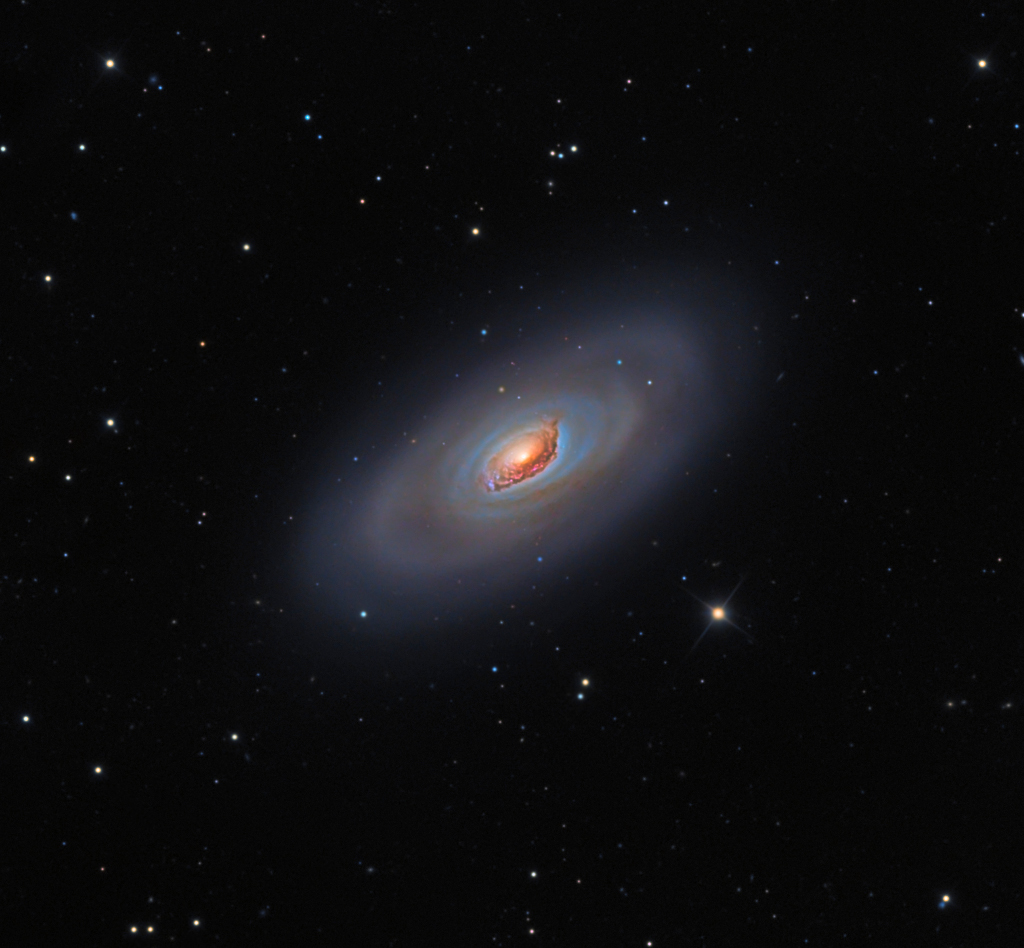 Image Credit & Copyright: Michael Miller, Jimmy Walker Explanation: This big, bright, beautiful spiral galaxy is Messier 64, often called the Black Eye Galaxy or the Sleeping Beauty Galaxy for its heavy-lidded appearance in telescopic views. M64 is about 17 million light-years distant in the otherwise well-groomed northern constellation Coma Berenices. In fact, the Red Eye Galaxy might also be an appropriate moniker in this colorful composition. The enormous dust clouds obscuring the near-side of M64's central region are laced with the telltale reddish glow of hydrogen associated with star forming regions. But they are not this galaxy's only peculiar feature. Observations show that M64 is actually composed of two concentric, counter-rotating systems. While all the stars in M64 rotate in the same direction as the interstellar gas in the galaxy's central region, gas in the outer regions, extending to about 40,000 light-years, rotates in the opposite direction. The dusty eye and bizarre rotation is likely the result of a billion year old merger of two different galaxies. Tomorrow's picture: pixels in space Πηγή
__________________
όταν γράφεται η ιστορία της ζωής σου, μην αφήνεις κανέναν να κρατάει την πένα |
 |
#3163
|
 |
|
||||
|
Discover the cosmos! Each day a different image or photograph of our fascinating universe is featured, along with a brief explanation written by a professional astronomer. 2015 June 19 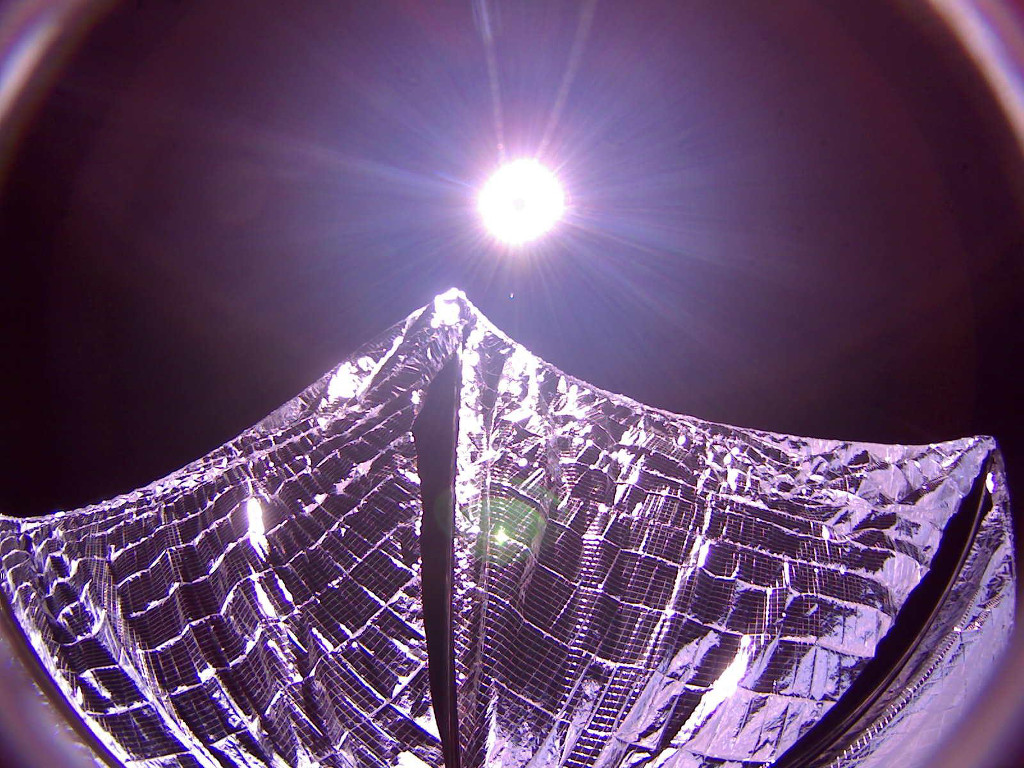 Image Credit: The Planetary Society Explanation: Hitching a ride to low Earth orbit, LightSail A accomplished a challenging test mission, unfurling its 32 square meter mylar solar sail on June 7. This dramatic image from one of the bread loaf sized spacecraft's fisheye cameras captures the deployed sail glinting in sunlight. Sail out and visible to Earthbound observers before its final orbit, LightSail A reentered the atmosphere last weekend. Its succesful demonstration paves the way for the LightSail B spacecraft, scheduled for launch in April 2016. Once considered the stuff of science fiction, sailing through space was suggested 400 years ago by astronomer Johannes Kepler who observed comet tails blown by the solar wind. But modern solar sail designs, like the one tested by LightSail A rely on the small but continuous pressure from sunlight itself for thrust. Tomorrow's picture: summer to summer Πηγή
__________________
όταν γράφεται η ιστορία της ζωής σου, μην αφήνεις κανέναν να κρατάει την πένα |
 |
#3164
|
 |
|
||||
|
Discover the cosmos! Each day a different image or photograph of our fascinating universe is featured, along with a brief explanation written by a professional astronomer. 2015 June 21  Image Credit & Copyright: Damian Peach/SEN Explanation: On Saturn, the rings tell you the season. On Earth, today marks a solstice, the time when the Earth's spin axis tilts directly toward the Sun. On Earth's northern hemisphere, today is the Summer Solstice, the day of maximum daylight. Since Saturn's grand rings orbit along the planet's equator, these rings appear most prominent -- from the direction of the Sun -- when the Saturn's spin axis points toward the Sun. Conversely, when Saturn's spin axis points to the side, an equinox occurs and the edge-on rings are hard to see. In the featured montage, images of Saturn over the past 11 years have been superposed to show the giant planet passing from southern summer toward northern summer. Although Saturn will only reach its northern summer solstice in 2017 May, the image of Saturn most analogous to today's Earth solstice is the bottommost one. Πηγή
__________________
όταν γράφεται η ιστορία της ζωής σου, μην αφήνεις κανέναν να κρατάει την πένα |
 |
#3165
|
 |
|
||||
|
Discover the cosmos! Each day a different image or photograph of our fascinating universe is featured, along with a brief explanation written by a professional astronomer. 2015 June 22 Video Credit & Copyright: National Space Society Explanation: In three weeks, the robotic New Horizons spacecraft will reach Pluto. As the featured video makes clear, though, humanity has been on an unprecedented epoch of robotic exploration of our Solar System's planets for the past half century. The video highlights artistic illustrations of Mariner 2 flying by Venus in 1962, Mariner 4 flying past Mars in 1965, Pioneer 10 flying past Jupiter in 1973, Mariner 10 flying past Mercury in 1974, Pioneer 11 flying past Saturn in 1979, and Voyager 2 flying past Uranus in 1986 and then Neptune in 1989. Next is a hypothetical sequence depicting New Horizons flying past Pluto next month. Assuming things works as planned, dwarf planet Pluto will then become the farthest world yet explored by humans. Of course, these Pluto illustrations are only a guess. How Pluto and its moons will really look may be a mixture of familiar things, such as craters, and unfamiliar things, such as … Tomorrow's picture: big bubble Πηγή
__________________
όταν γράφεται η ιστορία της ζωής σου, μην αφήνεις κανέναν να κρατάει την πένα |
 |
| Συνδεδεμένοι χρήστες που διαβάζουν αυτό το θέμα: 15 (0 μέλη και 15 επισκέπτες) | |
|
|